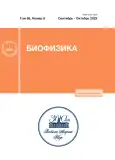Cell cycle parameters and ornithine decarboxylase activity in the red bone marrow of hibernating ground squirrels Urocitellus undulatus
- 作者: Aksyonova G.E1, Logvinovich O.S2, Afanasyev V.N1, Lizorkina K.I1
-
隶属关系:
- Institute of Cell Biophysics, Russian Academy of Sciences
- Gomel State Medical University
- 期: 卷 68, 编号 5 (2023)
- 页面: 964-972
- 栏目: Articles
- URL: https://journals.rcsi.science/0006-3029/article/view/233470
- DOI: https://doi.org/10.31857/S0006302923050174
- EDN: https://elibrary.ru/PGWGKV
- ID: 233470
如何引用文章
全文:
详细
作者简介
G. Aksyonova
Institute of Cell Biophysics, Russian Academy of Sciences
Email: aksyonovage@rambler.ru
Pushchino, Moscow Region, Russia
O. Logvinovich
Gomel State Medical UniversityGomel, Belarus
V. Afanasyev
Institute of Cell Biophysics, Russian Academy of SciencesPushchino, Moscow Region, Russia
K. Lizorkina
Institute of Cell Biophysics, Russian Academy of SciencesPushchino, Moscow Region, Russia
参考
- H. V. Carey, M. T. Andrews, and S. L. Martin, Physiol. Rev., 83 (4), 1153 (2003).
- F. Geiser, Annu. Rev. Physiol., 66, 239 (2004).
- Q. Guo, X. Mi, X. Sun et al., Sci. Rep., 7 (1), 10509 (2017).
- T0ien, K. L. Drew, M. L. Chao, and M. E. Rice, Am. J. Physiol., 281 (2), R572 (2001).
- T. R. Jinka, 0. T0ien, and K. L. Drew, J. Neurosci., 31 (30), 10752 (2011).
- M. S. Vinogradova, Comp. Biochem. Physiol. A, 91 (2), 235 (1988).
- I. I. Kruman, E. N. Ilyasova, S. A.Rudchenko, and Z. S. Khurkhulu, Comp. Biochem. Physiol. А, 90 (2), 233 (1988).
- В. М. Юнкер и Г. В. Алексеева, Эволюц. биохимия и физиология, № 2, 193 (1974).
- E. W. Carlier, J. Anat. Physiol., 27 (Pt 3), nil9, 354 (1893).
- Г. А, Клевезаль и А. И. Ануфриев, Зоологич. журн., 92 (4), 481 (2013).
- H. R. Bouma, A. M. Strijkstra, A. S. Boerema, et al., Vet. Immunol. Immunopathol., 136 (3-4), 319 (2010).
- S. T. Cooper, S. S. Sell, M. Fahrenkrog, et.al., Physiol. Genomics 48 (7), 513 (2016).
- Т. М. Шивачева и А. И. Хаджиолов, Арх. анат. гистол. эмбриол., 92 (5), 48 (1987).
- T. M. Shivatcheva and A. I. Hadjioloff, Dev.Comp. Immunol., 11 (4), 791 (1987).
- M. B. Al-Fageeh and C. M. Smales, Biochem. J., 397 (2), 247 (2006).
- J. Fujita, J. Mol. Microbiol. Biotechnol., 1 (2), 243 (1999).
- A. Roobol, M. J. Carden, R. J. Newsam, and C. M. Smales, FEBS J., 276 (1), 286 (2009).
- T. Neutelings, C. A. Lambert, B. V. Nusgens, et al., PLoS One, 8 (7), e69687 (2013).
- А. К. Гулевский, Ю. С. Ахатова и И. И. Щенявский, Probl. Cryobiol. Cryomed., 27 (2), 97 (2017).
- L. Hartwell, in Cell Cycle Control, Ed. by C. Hutchison and D. M. Glover, (Oxford University Press, 1995), pp. 1-15.
- C. W. Anderson, E. Appella, R. Bradshaw, and E. Dennis, in Regulation in organelle and cell compartment signaling (New York. Acad. Press, 2011), pp. 235-254.
- C. L. Rieder and R. W. Cole, Cell Cycle, 1 (3), 169 (2002).
- Z. Matijasevic, J. E. Snyder, and D. B. Ludlum, Oncol. Res., 10, 605 (1998).
- A. Moore, J. Mercer, G. Dutina, et al., Cytotechnology, 23, 47 (1997).
- Г. Е. Аксенова, О. С. Логвинович, Л. А. Фиалковская и др., Биохимия, 75 (9), 1257 (2010).
- H. M. Wallace, A. V. Fraser, and A. Hughes, Biochem. J., 376 (1), 1 (2003).
- Н. К. Бердинских, С. П. Залеток, Полиамины и опухолевый рост (Наук. Думка, Киев, 1985).
- A. E. Pegg, J. Biol. Chem. 281 (21), 14529 (2006).
- T. Thomas, T. J. Thomas, Cell. Mol. Life Sci., 58 (2), 244 (2001).
- R. M. Ray, B. J. Zimmerman, S. A. McCormack, et al., Am. J. Physiol., 276 (3), C684 (1999).
- D. L. Kramer, B.-D. Chang, Y. Chen, et al., Cancer Res., 61 (21), 7754 (2001).
- I. K. Kolomiytseva, L. N. Markevich, N. I. Perepelkina, et al., in Hypothermia: prevention, recognition and treatment, Ed. by J. I.V. Delgado and V. G. F. Garza (Nova Sci. Publ., N.Y., 2012), pp.1-42.
- V. N. Afanasyev, B. A. Korol, N. P. Matylevich, et al., Cytometry, 14 (6), 603 (1993).
- J. Janne, and H. G. Williams-Ashman, J. Biol. Chem., 246 (6), 1725 (1971).
- L. V. Slozhenikina, L. A. Fialkovskaya, and I. K. Kolomiytseva, Int. J. Radiat. Biol., 75 (2), 193 (1999).
- Г. И. Козинец, В. М. Погорелов, В.М. Котельников и др., Лаб. дело, № 7, 3 (1988).
- Д. А. Шмаров, Клин. Лаб. диагн., № 5, 40 (1993).
- H. R. Bouma, F. G. M. Kroese, J. W. Kok, et al., Proc. Natl. Acad. Sci. USA, 108 (5), 2052 (2011).
- C. C. Kurtz and H. V. Carey, Dev.Comp. Immunol., 31 (4), 415 (2007).
- M. Bohr, A. R. Brooks, and C. C. Kurtz, Dev.Comp. Immunol., 47 (2), 178 (2014).
- H. R. Bouma, G. J. Dugbartey, A. S. Boerema, et al., J. Leukoc. Biol., 94 (3), 431 (2013).
- T. Ohnishi, X. Wang, K. Ohnishi, and A. Takahashi, Oncogene, 16 (11), 1507 (1998).
- T. Sakurai, K. Itoh, Y. Liu, et al., Exp. Cell. Res., 309 (2), 264 (2005).
- H. Nishiyama, K. Itoh, Y. Kaneko, et al., J. Cell. Biol., 137 (4), 899 (1997).
- Г. Е. Аксенова, О. С. Логвинович, Д. А. Игнатьев и И. К. Коломийцева, Биофизика, 63 (2), 311 (2018).
- S. I. Hayashi and Y. Murakami, Biochem. J., 306 (1), 1 (1995).
- U. Mangold and E. Leberer, Biochem. J., 385 (1), 21 (2005).
- G. S. Travlos, Toxicol. Pathol., 34 (5), 548 (2006).
- R. W. Bullard and G. E. Funkhouser, Am. J. Physiol., 203 (2), 266 (1962).
- Н. М. Захарова, Фундаментальные исследования, 6, 1401 (2014).
- H. M. Zhang, J. N. Rao, X. Guo, et al., J. Biol. Chem., 279, 22539 (2004).
- S. Bhattacharya, R. M. Ray, and L. R. Johnson, Biochem J., 392, 335 (2005).
- P. Kucharewska, J. E. Welch, K. J. Svensson, and M. Belting, Biochem. Biophys. Res.Commun., 380 (2), 413 (2009).
补充文件









